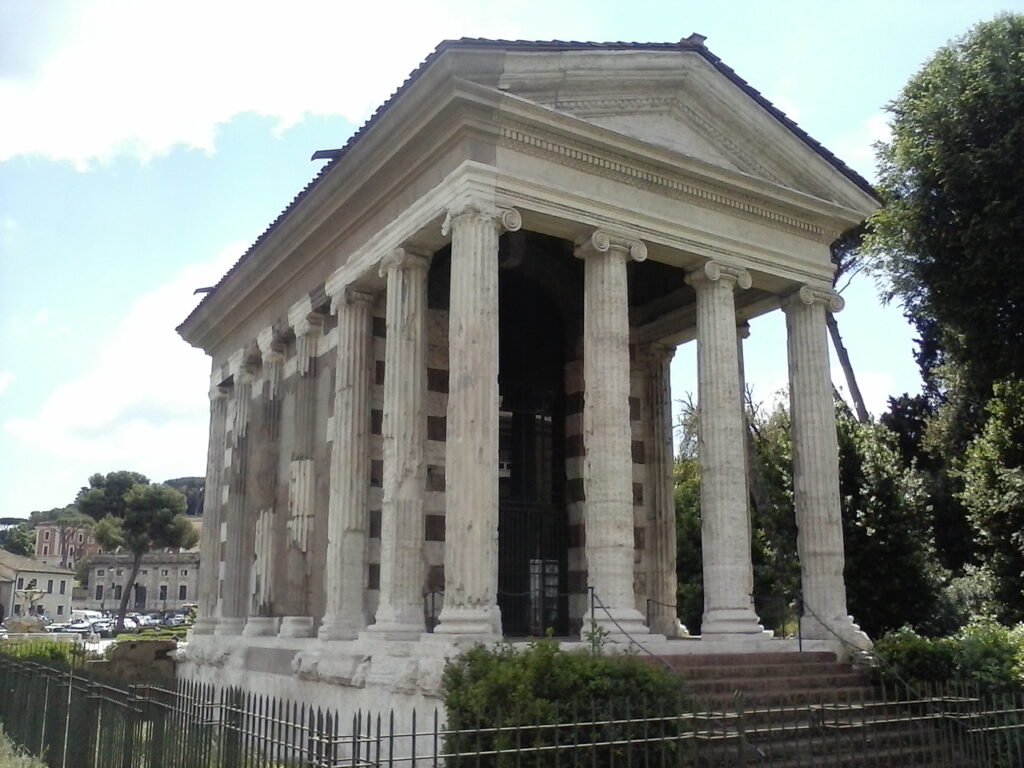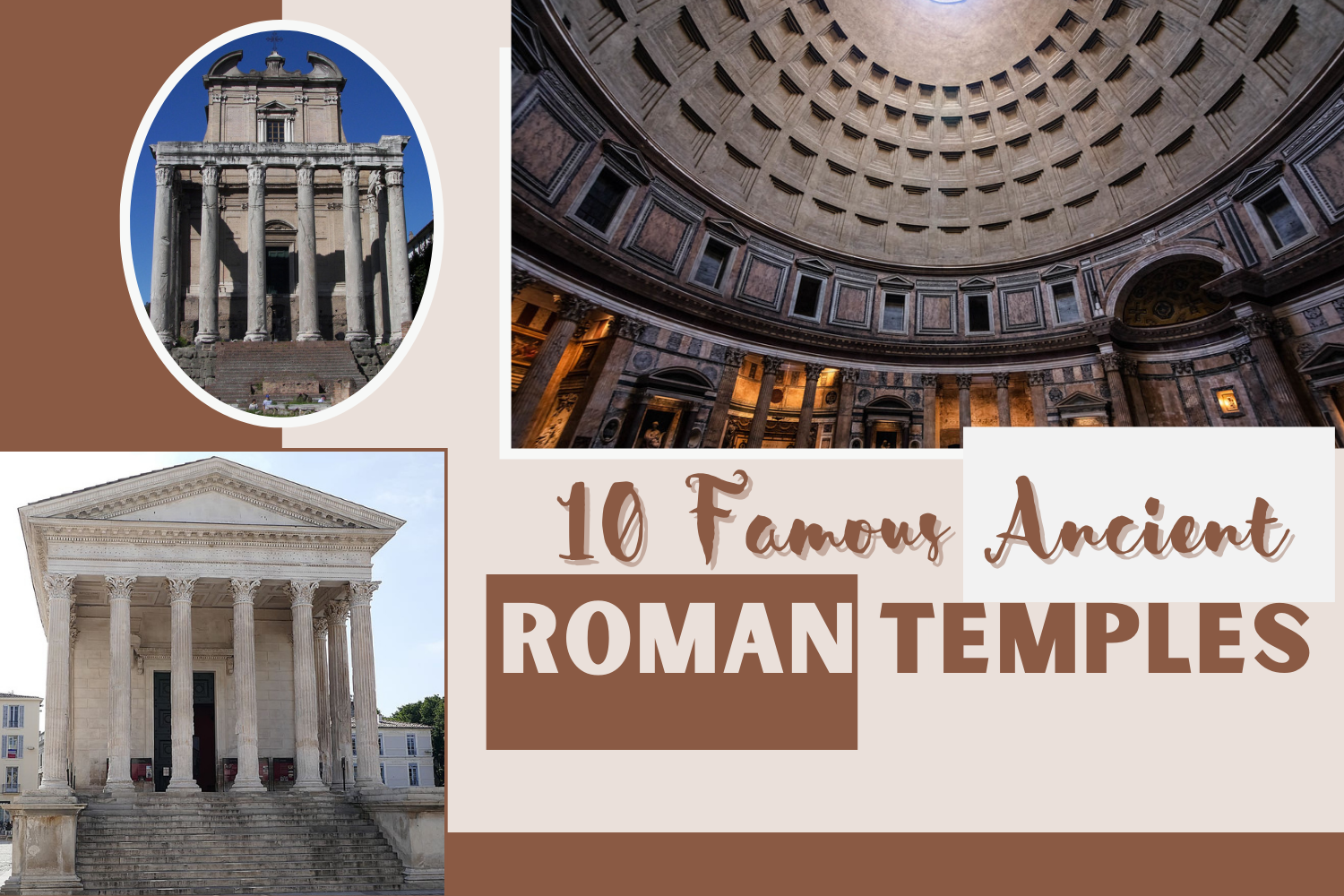10 Famous Ancient Roman Temples
Whether in today’s world or in ancient times, people have always felt the need for gods and deities, leading to the construction of Ancient Roman Temples.
They took inspiration from Greek culture in choosing their gods to pray. They had a firm belief in their gods and they always wanted to be on good terms with them.
The temples built by the Romans were unique in all forms. They were inspired by Eutrscans, which were a part of Tuscany.
The Roman columns were also inspired by Greek architecture. Other cultures inspired Roman Architecture.
Unique Architecture of Different Roman Temples

The classic Greek architectural style heavily influenced Roman Temples. The typical Greek style featured a rectangular plan with a frontal entrance, supported by columns.
The columns were often of the Doric, Ionic, or Corinthian orders. The choice of order depends on the temple’s purpose and the patron’s preferences.
The cella housed the main statue of their deity for praying. Every Roman temple built followed a certain set of rules.
For example: the total height of a column is based on the Classical Order of Architecture chosen. Everything is measured and spaced out based on the width of a column shaft measured at the bottom. Another example is how the roof angle should not be more than 22 degrees this applies to every “order of architecture.”
Every Roman temple holds historical significance based on the different gods for which builders constructed them.
Let’s see different Roman Temples with their significance in Roman history and their unique architecture.
1. The Pantheon
The Pantheon has remained the best-preserved Roman Temple for over 2000 years. It is the most recognized Roman symbol after the Colosseum where the ancient Romans did their ceremonies.
It was the house of all the major gods, such as Jupiter, Saturn, and Mercury. The Pantheon is a combination of two Greek words, ‘PAN’ and ‘THEON’ meaning all gods.
The Architecture of the Temple
This building was unique from all the other Ancient Roman temples. Because of its different design, the most unique and interesting part was its Rotunda.
It was a large and high circular hall forming a cylinder covered by a concrete dome with a wide hole in its center. This wide hole in the roof of Pantheon was called Oculus.
The Rotunda dome is 43 meters wide despite all the modern technology. It is still the world’s widest non – reinforced concrete structure.

2. Temple of Portunus
The Temple of Porturus is alongside the Tiber River, Forum Boarium of Rome. Named after the river god of the city, Portunus. He was the local god of the Forum Borium. Also, the god of ports, keys, wheat, and doors were his symbols.
Every year, the Romans celebrated the festival of Portunalia in honor of this god.
The Architecture of the Temple
Temple’s architectural style is in the ionic order. It is because of the capitals with scrolls on each column.
It has a fair-sized Podium foundation below the temple, reached by the staircase. The temple was primarily constructed using tuff stones known as tufa and travertine. It has four columns in the front and seven along its side.

3. The Capitol of Dougga
The Capitol of Dougga dates from the 160s AD, built by the co-emperors Marcus Aurelius and Lucius Verus. This temple was for Jupiter, the mighty god of the Roman civilization.
Romans often used to call Jupiter, Jupiter Optimus Maximus which means Jupiter the best and biggest in Latin.
The Architecture of the Temple
The temple is built in Corinthian style with Corinthian capital and only eight columns in the entrance. There is also a large block podium with a staircase.
The architecture of this temple is impressive. Looking through the middle columns a large niche in the cella back wall can be seen where the statue of Jupiter was placed.

4. Temple of Minerva
It is a Corinthian temple located in the Roman ruins of Sufetula, near Sbeitla, in Northern Tunisia. The temple is dedicated to the goddess Juno, a female counterpart of Jupiter.
She was the protector of women and marriage. It is located about 250 km from Tunis, the capital of Tunisia. The temple was built under the reign of Emperor Vespasian in the second century AD.
By observing the number and style of the columns, the Temple of Minerva is another Tetrastyle and Corinthian temple.
The Architecture of the Temple
It is a prostyle temple with columns in the portico area only. The tall square bottom column supports called Plinths are different and also interesting. It is built upon a podium base with a wide staircase. Without much decoration on the entablature or the pediment.

5. Maison Caree
This 2000-year-old temple is located in Nimes, France, once part of the Roman province of Gaul, during the Roman Empire.
This fabulous monument was built under the reign of Emperor Augustus around 20 BC. Unlike other Roman temples, it is dedicated to his grandsons, Gaius and Lucius Ceasar.
The Architecture of the Temple
The architecture of this temple kept evolving because of the restoration practices on the temple. These restorations started in the 1800s when this temple was the Austinian Convent Church.
The serious restoration began in 1816 by an engineer Stanislas – Victor – Grangent. The process restored the roof and podium and installed a new bronze door in 1824.

6. The Temple of Antoninus and Faustina
This temple, located in Rome, Italy, was built in 141 AD. It was not consecrated to the twelve major gods but dedicated to the deceased wife of Emperor Antoninus Pius. After the Emperor’s death, it was dedicated to him along with his wife. Today, people know this ancient Roman temple as the church of San Lorenzo in Miranda.
The Architecture of the Temple:
Many alterations to the interior Cella of this temple caused the original temple roof to disappear. Despite losing some features, the temple still retains some beautiful aspects.

7. Temple of Saturn
The temple is dedicated to the Roman god Saturn, built around 500 BC. Unfortunately, this temple was plagued by fire in the 400s BC 42 BC and again in 360 AD. The temple of Saturn in today’s time was reconstructed in 300 AD.
The Architecture of the Temple
The brilliant architect of the temple shows the front ten columns freestanding and other columns partially embedded in walls.
It was a pseudoperipteral temple and not a peripteral temple, with a width of six columns, a length of eleven columns, and a total of thirty columns.
An altar was constructed outside the temple where they sacrificed to the god.

8. Temple of Jupiter Heliopolis
Temple of Jupiter Heliopolis is the largest Roman temple ever built, dedicated to the supreme Roman god Jupiter.
The construction of this magnificent temple was completed around 60 AD. Situated in Baalbek, Lebanon, it was known as Colonia Julia Augusta Felix Heliopolitana during Roman times.
Because of the temple’s location, this version of the god is popular as Jupiter Heliopolitanus to the people.
The Architecture of the Temple
The temple of Jupiter Heliopolis was the largest in the Roman empire. It has a width of ten columns in front and a length of nineteen columns alongside, with a total of fifty-four columns on all four sides.
It’s each column was eighteen meters high and two and a half meters wide. Adding together the height of all the columns. The structure stood up to 46 meters high, equal to the height of the Statue of Liberty.

9. Temple of Venus
The Temple of Venus is dedicated to the goddess Venus. The temple dates from the third century AD at Baalbek, Lebanon. The temple is unique and relatively small from all the massive Roman temples of the Empire.
This temple has a resemblance to the Pantheon in Rome because of its Portico entrance in front and Rotunda in the rear, covered with a dome.
The Architecture of the Temple
This beautiful temple signifies that Roman architects were imaginative and creative in their designs. Always willing to construct Roman temples that wandered rather far more conventional than classic Greek Architectural Designs.

10. Temple of Hercules Victor
The temple of Hercules Victor is unique in its design because it is round. Buildings round in shape are known as Rotunda, a term commonly used by ancient Romans and architects today. It was built in around 100 BC.
This temple survived because people converted it into a church and changed its name three times, from Santo Stefano Rotondo to Santo Stefano alla Carozz, and finally to Santa Maria del Sole.
The Architecture of the Temple
The temple features a circle of surrounding columns with a round Cella room, constructed using original travertine stones for the walls.
Observers can note the temple’s unique architectural design, characterized by a three-step stylobate made of volcanic rocks on which the temple rests, unlike the podiums upon which other Roman temples typically stand. The temple was 33 feet high and 50 feet long.

Roman Temples, The Era It Was Built In, The Deity It Denotes, And Where It Is Located Today.
| Roman Temple | The era it was Built | Deity it denotes | Today’s Location |
| The Pantheon | Between 25 and 27 BC | Jupiter, Venus, and Mercury | Rome, Italy |
| Temple of Portunus | 400s BC | God Portunus | Rome, Italy |
| The Capitol of Duogga | 160s AD | God Jupiter | Tunisia |
| Temple of Minerva | 2nd Century AD | Goddess Juno | Sufetula, Tunisia |
| Maison Caree | 27 BC – 68 AD | Grandsons of Emperor Augustus-Gaius and Lucius Ceasar | Nimes, France |
| Temple of Antoninus and Faustina | 141 AD | Emperor Antoninus and wife Faustina | Rome, Italy |
| Temple of Saturn | Around 500 BC | God Saturn | Rome, Italy |
| Temple of Jupiter Heliopolis | 60 AD | God Jupiter Heliopolis | Baalbek, Lebanon |
| Temple of Venus | 3rd Century AD | God Venus | Baalbek, Lebanon |
| Temple of Hercules Victor | 100 BC | God Hercules Victor | Rome, Italy |
Why Roman Temples were built?
Usually, Roman Temples were designed by the Patron’s architects. They dedicated their religious purity and surrendered themselves to a particular deity or religion.
Whenever a new religion was introduced to Rome, a new temple was constructed for the particular god or goddess with their statue.
These temples were made as the ‘seat for the god’. To give a house to the deity and possession of the land was made in the name of the deity in an act called ‘consecratio’.
Some Roman Temples were created to denote and mark the success of the Roman Empire. Most of these temples were built from loot of war that was promised impulsively by the emperor.
This influenced the materials Romans used to create these historical and beautiful monuments. The use of gold and ivory in the statues of the imperial age. It broadly differed from the archaic terracotta predecessors.
Some Temples did not only worship the Roman gods but other cultural deities as well. As we see the sanctuary of Mater Magna contains deities from many cultures.
The sanctuary can be observed by Greco-Roman sculptures including Heracles Victor, Artemis with Iphgeneia, Athena, Venus Dionysus, Sylvanus, and Apollo. Egyptian deities like Uraei of Isis and a combined relief containing Isis, Serapis with Jupiter Dolichenus, and his female partner.
Different Theories about the Pantheon
We know that the Pantheon is a beautiful architecture from ancient Rome. But there are some questions and theories about the Pantheon that are still unanswered. Let’s discuss some of these theories for better understanding.
- It is evident from Roman history that Romans did not worship different gods together, so the construction of the Pantheon to worship all gods together creates a contradiction.
- It is believed that Roman gods didn’t appreciate sharing a temple with other gods. But there are some exceptions like the conjoined temple of Caster and Pollux because of their same purpose. The temple of Antoninus and Faustina who were husband and wife. But rather than these, Roman temples were generally built for single deities.
- There is also a strong theory proposed by a professor of archeology that the Pantheon was built to worship the Emperors yet to be defied. It was evident in the historical relics that Romans worshiped their Emperors after their deaths.
- Documentation confirms that the Pantheon served as a setting, diverging from the conventional temple style, where following his death, the emperor would be portrayed in the company of gods.
- The perfect hemispherical shape of the dome can fit a sphere of exactly 44.4 meters in diameter. Thus, the construction of the Dome is still a mystery. According to some theories, a complex scaffolding was used to lay the concrete.
The Impact of Ancient Roman Temples on Modern Architecture
Ancient Roman Temples had a huge impact on the architectural techniques of the modern world. We can see the monuments and buildings built today, and have a glimpse of the Roman architectural style.
For example, we can observe that the White House features arches and columns on its exterior, just like the construction of Roman temples. Let’s see the different ways in which Roman temple architecture influenced modern architecture and design:
- Roman architecture used concrete, brick, and stone extensively. The use of these materials heavily influenced the evolving modern architectural practices. Use of these materials in the construction of modern buildings for better durability and longevity.
- The Romans often used civic and religious influence while constructing their temples. Often served as models for government and religious buildings. Architects often draw inspiration from Roman temples for government and religious monuments in modern architecture.
- Romans perfected the use use of Arches in their designs. This innovation by the Romans laid the foundation of many modern-day architectures such as Gothic arches in medieval architecture.
Why Did The Traditional Roman Practices Decline?
The main reason behind the decline and fall of traditional Roman practices was the change in religious belief by people and the influence of Christianity.
The rise of different religions in Rome led to the fall of Roman traditional belief. The main religion influencing the Romans was Christianity.
The Christian religion was monotheistic meaning believing in one god and it was counter to the traditional Roman religion which was polytheistic meaning believing in many gods.
This fall of Roman religion began when Emperor Constantine the Great ended all persecution and declared toleration for Christianity.
The drastic change in the policy spread this new religion all over the country. Approval of Christianity by the Roman state directly undermined its religious practices.
As history tells us, the Romans considered their emperors as gods. But the Christians served one god so this weakened people’s belief in their Emperor. Also, his authority and credibility over his population.
Another reason for the acceleration of Christianity in Rome was that Constantine split his empire into two parts: the Western part centered in Rome while the Eastern part centered in Constantinople.
The Western Empire spoke Latin and was Roman Catholic, while the Eastern Empire spoke Greek and followed a Christian Church.
As time passed the Western Empire declined and the Eastern Empire continued the Christian religion in Rome.
Comparing Roman Temples Designs With Greek Temples Design
Though The Roman and Greek temples’ architecture looks similar. They are very different in their design, the Romans took inspiration from the Greek architectural designs. But they had their ideas for designing their temples. Roman and Greek temples differ in three major ways:
- Classical orders of architecture
- Foundation of the temple
- Method of Calculation for Columns
Classical Order Of Architecture
The Empires followed five classical orders of architecture – Corinthian, Ionic, Doric, Tuscan, and Composite – when constructing their temples and monuments.
The difference between Roman architectural designs and Greek architectural designs was that Romans used all five orders of architecture while constructing their temples but the Greeks used only three orders of architecture while constructing their temples and these three orders were Doric, Ionic, and Corinthian.
Foundation Of The Temple
The foundations used by the Greeks and Romans while constructing their temples were very different from each other. The Romans used high podiums to build their temples with a staircase in front and two abutments projecting out from either side of the stairs.
While the Greeks built their temples on a low Stylobate also known as the crepidoma, a foundation composed of three steps running along all four sides.
Method Of Calculation For Columns
Roman and Greek temple designs have columns in them, but the methods of calculating the number of columns in the temple are different.
The Roman Method
The Roman Equation is to multiply the number of columns in front by two and subtract one column. Thus, a Roman temple with six columns in front will have eleven columns on the side. It is the Roman method of Columniation.
The Greek Method
The Greek equation was to multiply the number of columns in front by two and add one column, so the Greek temple having six front columns will have thirteen columns alongside.
Wrapping-Up
Roman temples were a significant architectural and religious aspect of ancient Roman civilization, playing a central role in the expression of Roman religious beliefs and cultural identity. In conclusion, we can highlight several key points about Roman temples.
- Architectural Innovation: Roman temples borrowed heavily from Greek architectural styles but also introduced their innovations, such as the use of concrete and the development of the Corinthian order, showcasing their engineering and architectural prowess.
- Religious Significance: They dedicated temples to various Roman gods and goddesses, reflecting the polytheistic nature of Roman religion. They served as places of worship, sacrifices, and rituals, connecting the Roman people to their deities.
- Urban Planning: Urban planners integrated temples into urban planning, often utilizing them as focal points in cities, demonstrating the importance of religion in Roman society. Their impressive facades and grandeur symbolized the power and glory of Rome.







